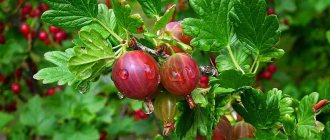Due to the redevelopment of the site or for other reasons, the plants are transplanted to another place. To prevent the crop from dying, you need to choose the right time, prepare the site and the seedling itself. Now we will look at how to replant blackberries and provide the plant with proper care for further development.
Why replant blackberries to a new place?
Wild blackberries can grow in one place for up to 30 years. After 10 years, a cultivated plant must be transplanted to another place. The process consists of carefully digging up the bush, trimming all branches, and carrying the root system with a lump of earth. The plant is planted in a new hole so that the root collar remains at the same level.
The main purpose of replanting is to renew the bush. You can propagate your favorite variety using the division method. Replanting may be necessary simply in case of redevelopment of the yard or if it is necessary to divide a huge overgrown bush.
If you decide
As you can see, there are no special contraindications to planting the crop in the autumn. We will learn in detail how to properly plant and care for garden blackberries in the fall.
Selection of seedlings
Experienced gardeners advise buying blackberry seedlings from special nurseries that breed blackberries. There is a variety of varieties of both ordinary garden and remanent species.
The latter is now becoming increasingly popular due to the fact that it bears fruit longer and is more resistant to both weather conditions and diseases. There are planting materials with high and low levels of shoot formation.
Important! A bud should already be formed on the roots of the blackberry seedling; without it, planting will not make sense.
You also need to pay attention to the root system - it should be healthy in appearance with no signs of rotting. Immediately before planting, you can soak the roots in a solution of a teaspoon of 3% hydrogen peroxide per liter of water.
This will kill any parasites if present and give the roots additional oxygen.
Choosing and preparing a place
Before planting blackberries in the fall, you need to decide on a planting site and prepare it.
Important! You cannot plant blackberries in places where vegetable crops were previously located. In order for the plant to feel good, it needs a sunny place.
You also need to remember that blackberries produce a lot of shoots, so a distance of about 1.5 m should be maintained from the place where they are planted to buildings and fences.
In order for the plant to feel good, it needs a sunny place. You also need to remember that blackberries produce a lot of shoots, so a distance of about 1.5 m should be maintained from the place where they are planted to buildings and fences.
About 5 kg of manure or compost, up to 150 g of superphosphate and three times less potash fertilizers are added to the pit.
It is important to mix fertilizers well with the soil so that plant roots do not come into contact with them. Gardeners say that after such fertilization the soil is fertile for about 4 years
Planting scheme
The planting scheme for garden blackberries directly depends on whether the plant will produce many or few shoots. If the formation of low-level shoots, the so-called bush method is used. Several seedlings are placed in one hole, the distance between them should be slightly more than 1.5 m.
The tape planting method assumes a high level of shoot formation. Each seedling is planted in a separate hole in a row, the distance between which is about a meter. The width between rows is from 2 to 2.5 m.
When planting, straighten the roots of the plant well, sprinkle with soil and water
It is important that no air pockets form and that the bud is at least 3 cm above the ground
Did you know? Thornless blackberries are propagated only by cuttings from young shoots. If you propagate by roots, then the seedlings will later have thorns.
The time to plant blackberries in the fall is from the end of summer until the first serious cold weather. September is best for this. It is warm enough and the plant will have time to take root before the cold weather.
When is it better to replant blackberries: in spring or autumn?
Blackberries are replanted in spring and autumn. However, each season has its own advantages and disadvantages. The optimal timing of transplantation is determined taking into account the climatic conditions of the region.
The advantages of transplanting in early spring are the guaranteed survival rate of the seedling. This option is more suitable for northern regions, since a plant transplanted in autumn does not have time to take root before frost. The disadvantage of spring transplantation is the difficulty of accurately determining the timing. It is necessary to catch that short period during which the process of sap flow has not yet begun, and the earth has already thawed after the winter.
Important! During the spring transplantation of blackberries, you should not oversaturate the hole with fertilizers. The root system that has not taken root is severely damaged.
A positive feature of autumn transplantation is the rooting of the seedling. In early spring the plant grows quickly. However, blackberries need to be replanted two months before the expected date of frost. For the winter, the seedling is well insulated. For the northern regions, the autumn method of transplantation is not available, and this is a big drawback. The advantages of the method are fully appreciated by residents of the south.
Care and shelter for the winter
After planting blackberries in the fall, it is important to monitor soil moisture. It should not dry out as quickly as in summer, but it should not be allowed to dry out. Mulching will retain moisture, which will reduce the frequency of watering.
On average, a young plant will require 3-4 waterings per week (depending on ambient temperature). When using mulch – 1 watering. The plant must be watered before frost.
It is recommended to cover the seedlings during winter if the area is characterized by severe frosts with wind and no snow. Snow is a natural “insulation” and can protect the plant from freezing. Provided that it falls out in a layer of 50 cm and lasts long enough.
If snow in winter is an infrequent occurrence, then care should be taken to cover the seedling. To do this, you can use the following methods:
- cover the seedling with peat or humus in a layer of at least 15 cm;
- cover the plant with plant “garbage” (branches and leaves);
- cover young shoots with agrofibre;
- use old plastic bottles (PET), which are placed on top of the seedling (cut three- or five-liter eggplants with a small hole on the side for air circulation are suitable).
The soil around the plant should be well mulched, even if the region does not experience very low winter temperatures.
When can you replant blackberries to another place?
The specific timing of transplantation in the spring is determined by weather conditions. Usually falls in April. In May, blackberries can no longer be touched. The plant begins the active phase of sap flow.
The time for autumn transplantation falls at the end of September - beginning of October, provided there are no early frosts in the region.
Attention! A seedling transplanted in the fall, even of a frost-resistant variety, is covered for the winter.
Set of preparatory measures
The transplantation process is conventionally divided into two stages: preparatory and main work. The actions are the same for thorny and thornless varieties of blackberries.
Selecting a suitable site
The site for transplantation is selected according to similar rules observed when planting a young seedling. For the plant, choose a sunny place, protected from northern winds. It is advisable to choose a hill, but make a depression for the seedling itself. On a mound, the blackberries will not be flooded by rain and melt water, and the hole under the plant will better retain water during watering.
The site is selected with loamy or sandy loam soil. You can replant the crop into a garden bed where any garden crops grew last season, except for nightshades and berries.
Soil preparation
In order for the transplanted bush to take root, you need to carefully prepare the soil:
- carry out a soil acidity test and, if necessary, bring it to neutral levels;
- the site is dug up to a depth of 50 cm;
- roots of weeds are selected from the ground;
- spread a 10 cm layer of compost and a 3 cm layer of any crushed organic matter evenly over the bed: leaves, sawdust;
- Calcium, phosphorus, and magnesium are added from mineral fertilizers;
- all layers are dug up again along with the soil;
- the bed is generously filled with water, covered with an 8 cm layer of mulch to speed up the process of overheating of organic matter;
- A trellis is installed at the site where the seedling is supposed to be planted.
When preparing the soil for replanting blackberries, the acidity is increased by adding iron sulfate at the rate of 500 g/10 m2. You can add 300 g of sulfur to a similar area, but the process will go slower. To reduce acidity, lime is added.
Preparation of planting material
To transplant blackberries to another place, you first need to dig them up. They try to dig a mature bush as deeply as possible with a shovel from all sides. The plant is removed from the soil so that a lump of earth remains. In this state, the blackberries are transferred to another place.
The preparation of an adult bush begins with pruning the above-ground part. You cannot leave stumps from old branches, as pests will infest them and the plant will disappear.
If a large bush is transplanted, it is propagated by division. The process consists of the following steps:
- the plant to be transplanted is dug up from all sides, removed from the ground, and the lump of soil is carefully kneaded to free the roots;
- the bush is divided with a sharp knife so that each cut off seedling has 2-3 branches and 1 underground bud on the roots;
- The divided planting material is planted in prepared holes.
Dividing the bush during transplantation can be done in the spring immediately after the snow melts or in the fall 2 months before the onset of frost.
Attention! An old blackberry bush cannot be divided. The plant is replanted only as a whole.
Transplanting bushes
After the preparatory activities, the main process begins.
Algorithm of actions on how to transplant blackberries to a new place:
- Carefully, without damaging the rhizome and shoots, dig up the old bush. To do this, it is better to dig up the plant with a shovel and pull it out with a clod of earth using a garden fork.
- Straighten the roots, remove excess shoots and branches, place the bush in the planting hole. If the shrub is old, it can be divided into several seedlings and planted separately in pre-prepared trenches.
- Sprinkle with loosened soil and compact. The growth bud should be buried 1-2 cm. If you place it deep, it will not be able to break through. When planting a plant with a bud above the top layer of soil, it will die due to exposure to bad weather conditions and strong winds.
- Sprinkle well with water and mulch the bush.
Transplanting blackberries to a new place in the spring
When transplanting, the mother bush can be propagated not only by division, but also by root shoots. The latter method involves planting seedlings from young shoots. Regardless of the method of reproduction, transplantation is carried out in the following order:
- Before transplanting, plan the location of the plants in the garden bed. Blackberries are planted in rows. Between seedlings of upright varieties, a space of up to 2 m is left. For creeping crops, the distance is increased to 3 m. The row spacing also depends on the type of bush and ranges from 1.8 to 3 m.
- If young shoots are used for transplantation, then a hole is dug 50 cm deep, with a diameter the size of the root. For an old bush, a hole is dug according to the dimensions of the root system. It is better to transplant blackberries into trenches 50 cm deep, dug along the length of the bed.
- During plant replanting, 1 bucket of compost and 100 g of mineral complex fertilizers are added to each hole, but it is better to get by with organic matter alone.
- The bush to be transplanted is dug up from all sides. In an adult plant, the root goes deep into the ground. It will not be possible to remove it. The rhizome is simply cut off with a shovel bayonet.
- The blackberries are carefully transferred, immersed in a new hole, and covered with earth.
After transplantation, the plant is watered abundantly, maintaining moisture until complete engraftment. After watering, the tree trunk soil is covered with mulch.
Video: features of autumn planting blackberries
Breeders have developed many varieties of winter-hardy and even thornless blackberries, so you should not be afraid to plant this crop in your summer cottages. If you follow the rules of agricultural technology and appropriate care, you will be able to enjoy the taste of these wonderful berries even in the northern regions.
- Author: Svetlana Lukyanova
I write with pleasure and about many things. Rate this article:
- 5
- 4
- 3
- 2
- 1
(3 votes, average: 5 out of 5)
Share with your friends!
Transplanting blackberries to a new place in the fall
Autumn replanting begins after fruiting has ended. There should be about two months left before the onset of frost. During this time, the transplanted plant will have time to take root. The process of autumn and spring transplantation is identical. The only difference is the protection of the seedling from frost. After the autumn replanting, the tree trunk soil is covered with a thick layer of mulch. Additionally, before the onset of winter, they organize a reliable shelter made of spruce branches or non-woven material.
You can replant in the fall not the entire bush, but young shoots from the roots. They are called offspring. Young shoots are the best option for preserving and propagating the variety, as it eliminates the complex process of replanting an old bush.
Many varieties of creeping blackberries do not produce offspring. In order not to replant the old bush, the crop is propagated by layering. In August, the blackberry vine is bent to the ground and covered with soil, leaving the top. After a month, the cuttings will take root. The resulting seedling is separated from the bush in September and transplanted to another place.
Choosing the right seedling
It is advisable to purchase planting material in special nurseries, where various forms of garden and remontant blackberries are presented.
The remontant variety receives more positive reviews - its fruiting is more extended, and its resistance to climatic conditions and diseases is much higher.
As for the level of branch formation, from this point of view it is better to give preference to annual specimens with several shoots, the diameter of which is more than 0.5 cm.
Also pay attention to the rhizome - it should look healthy, without signs of rotting. An eye should already be formed on it. An hour before rooting, the roots can be kept in a solution of 1 liter of water and 1 teaspoon of 3% hydrogen peroxide.
Is it possible to replant blackberries in summer?
Theoretically, summer replanting of blackberries can be done, but there is no guarantee of 100% survival of the plant. For testing, it is better to choose a variety that you don’t mind. To ensure a successful summer transplant, adhere to the following rules:
- transfers are carried out early in the morning or late in the evening;
- all work is completed as quickly as possible;
- immediately after transplanting, a shading structure is installed over the blackberries;
- Water the transplanted plant abundantly every day.
In summer, heat is detrimental to a dug-out plant. If blackberries are not immediately planted in a permanent place, they will quickly wither.
Caring for blackberries after transplantation
Caring for a transplanted plant is no different, as for other blackberry bushes. Initially, abundant watering is needed. You can’t rush with feeding. Mineral fertilizers can burn the root system that has not taken root. Over time, after adaptation to a new place, you can begin to add organic matter.
Caring for transplanted blackberries requires standard actions:
- In autumn and spring, pruning and shaping of bushes is carried out. Blackberry vines are tied to a trellis. For the winter, the stems are bent to the ground and covered with spruce branches or other insulation.
- In summer, blackberries are sometimes attacked by the gall mite. You can fight the pest with chemicals or garlic infusion.
- After the heat has subsided on warm evenings, the blackberries are irrigated with cool water. Sprinkling hardens young stems.
- The next spring after transplanting, the blackberries are fed with potassium during the appearance of buds.
The transplanted plant initially requires proper care for rapid rooting.
More details about transplanting blackberries are shown in the video:
Preparing bushes for transplantation
Selecting and preparing a site is the initial stage of transplanting blackberries to a new location in the fall.
Selection and preparation of site and soil
Bushes must be planted in accordance with the following conditions:
- The place should be well lit by sunlight, protected in spring and summer from strong dry winds, without stagnation of cold melt water and with the formation of a high snow cover in winter.
- Well-drained medium loams are suitable for planting.
- The groundwater level must be at least 1.5 m.
- Excessive moisture and poor soil aeration are not allowed.
Some gardeners are redeveloping the site and do not know whether it is possible to replant the plant near outbuildings. During normal development, a blackberry bush produces many shoots. Therefore, it is required to maintain a distance of at least 1 m from the house, fence or fence.
Preparing the pit for transplantation
To plant blackberries correctly, you need to know how far the bushes should be between each other and how deep the hole should be.
Professional gardeners advise maintaining distance between plants when planting in a row:
- for creeping species - 2-3 m;
- for upright ones - 1.5-2 m.
The row spacing should be at least 1.8-2.5 m. The optimal dimensions of the hole are 40x40 cm, but they depend on the size of the root. If you plant bushes using the trench method, the length of the trench should be at least 2 m.
We recommend that you read: Feeding currants and gooseberries
Preparation of the planting pit is as follows:
- Remove fallen leaves, debris, and weeds from the area.
- Dig up the soil.
- Dig a hole a little wider and deeper than required.
- Add fertilizer to it. You can put half a bucket of compost or humus, 150 g of superphosphate and 50 g of potassium.
- Mix the nutrients thoroughly with the soil.











